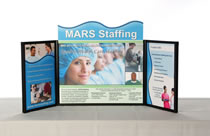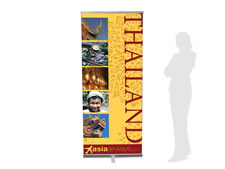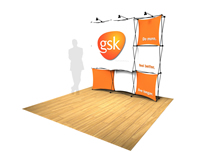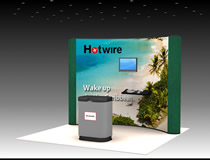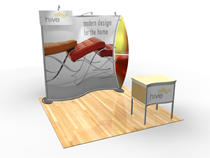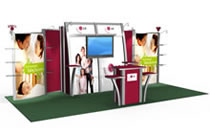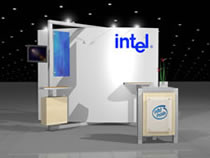Choosing the right trade show display is rarely straightforward. Most of the time, you are selecting between two similar but slightly different displays. Sometimes it’s about the price. Other times it’s about a personal design preference. Many times, it comes down to weight and assembly.
We can’t cover every scenario, but we can review some of the more common “this or that” portable/modular choices. You gotta make a decision . . . which one will you choose?
Briefcase Table Top vs. Full-size Table Top
This comes down to price, presentation, convenience, and assembly. Briefcase table tops tend to be smaller than traditional pop up, fabric, or hybrid table tops. There’s no assembly, unless you have a header, which may add another minute to the setup time. They are functional, convenience, and durable. Pop up, fabric, and hybrid table tops are almost always larger than briefcase table tops and may include options like backlit headers, lights, seamless graphics, and literature holders. Price varies from $400 to $2000 depending on accessories and design.
Insider Tip: College recruiters love briefcase table tops. Pharmaceutical reps like pop ups or hybrid table tops.
Full-size Table Top vs. Banner Stand(s)
This one is tough. Full-size table tops on a 6 ft. table make a great backdrop to any 10 x 10 space. The graphic area is large enough to convey one or two messages and your display will probably look different than your neighbor. Banner stands are lightweight, easy to assembly, and can be placed at the back of the booth or on the aisle. It’s not uncommon to see three banner stands placed side-by-side to create a semi-uniform large image.
Insider Tip: Why choose one or the other . . . Get both! It’s affordable and gives you the ability to take advantage of a table and the fill the booth space without adding clutter.
Banner Stand vs. Fabric Pop Up Display
This one depends on how many banner stands you want. One or two banner stands in a 10 x 10 space is not a display, and frankly it looks cheap and ridiculous. Two banner stands with a case to counter conversion is much better. A fabric pop up like Xpressions fills the backwall and takes about the same time to setup as multiple banner stands. The difference is price and design. Fabric pop ups are more expensive, but offer more visual impact.
Insider Tip: Both a banner stand and a fabric pop up give the ability to change your graphics frequently. In general, changing the graphic on a fabric pop up is easier than changing the graphic on a banner stand.
Fabric Pop Up vs. Pop Up Display
This is really a matter of taste. Fabric pop ups require less assembly time since the graphics are attached to the frame. Fabric pop up graphics are a series of tension fabric images attached to a visible straight frame. Pop up panels are unrolled and then hung on the frame. Pop up graphics are usually mural lambda or inkjet graphics attached to a curved frame. Pop up systems generally have more accessories such as shelves, literature holders, and monitor mounts.
If you want a seamless, single graphic, go with a pop up. If you want a series of images which create a unified theme or message, got with a fabric pop up.
Insiders Tip: You’ve heard it before, but you get what you pay for. The prices for these systems are all over the board. Ask lots of questions and less than you need or more than you’ll use.
Pop Up vs. Portable Hybrid Display
Pop up displays have been the mainstay of the portable exhibitor for over 20 years. Portable hybrids are the interlopers, offering more design options but at a higher price. You can’t go wrong with a pop up display, but you aren’t going to win any design awards. Walk any trade show and you’ll see a pop up display on every aisle. They are effective but not sexy anymore. Portable hybrids come in a variety of design flavors and options. The large format graphics are tension fabric, making them lightweight and durable. The downside . . . portable hybrids rarely ship as compact as pop ups and the setup time can be double. Most portable hybrids require some tool assemble, although newer systems like the Perfect 10 and Sacagawea are either tool-free or mostly tool-free.
Insiders Tip: Portable hybrids come in all price points, from $3500 to $13,0000 for a 10 x 10 display. This is one of the few instances where the price point corresponds directly with the options, design flair, and graphic elements. More money means more curves, larger graphics, more accessory options (and often better packaging).
Portable Hybrid vs. Modular Hybrid Display
What is a hybrid? In short, it’s a display that incorporates engineered aluminum extrusion, tension fabric graphics, and other stuff (which varies by design and manufacturer). Portable hybrids pack in roto-molded wheeled cases. Modular hybrids pack in roto-molded tubs or small wood crates. Portable Hybrids, such as Magellan are lightweight, economical, and attractive, but may not have all the bells and whistles such as extensive storage, large screen monitor capability, puck lighting, and multiple graphics. Modular Hybrids, like Visionary Designs, allow you to create whatever you want. The only limitation is your budget.
Insiders Tip: The terms modular hybrid and custom hybrid are often used interchangeably. Frankly, there are not enough differences to quibble.
Modular Hybrid vs. Modular Laminate Exhibit
Bear with me on this. It’s a little esoteric. If you read the previous section, you know what Modular Hybrids are all about. Modular Laminate exhibits are are primarily modular laminate panels rather than aluminum extrusion and tension fabric. That said, Modular Hybrids may have some laminate components, and Modular Laminates may have some aluminum and fabric components. It’s just depends on which material is the primary building block. Why choose one over the other? Some people love the the look of laminates. Others prefer large format fabric graphics. It all comes down to personal tastes and the image you are attempting to project.
Insiders Tip: I’m a snob when it comes to modular laminate systems. I have a right to be. I’ve seen every variation over the past 15 years. The best ones are lightweight, durable, two-sided, and simple to install. The worst ones have taken a simple idea and created a mechanical Rubik’s Cube with springs and funky locks. Simple and durable are always better in this case.
–Mel White
http://www.linkedin.com/in/melmwhite
mel@classicexhibits.com




